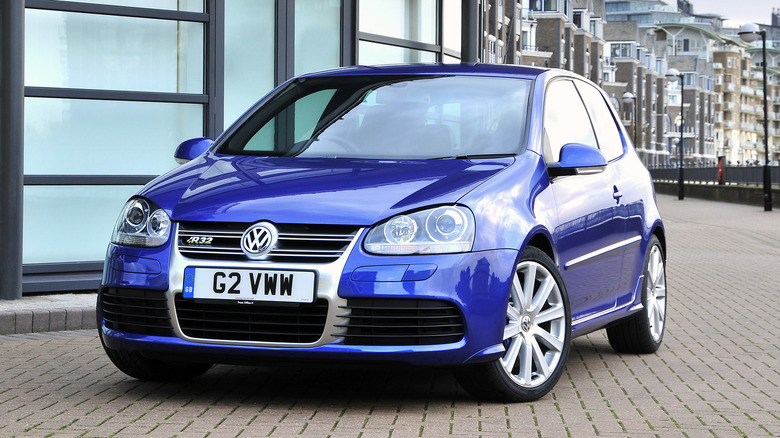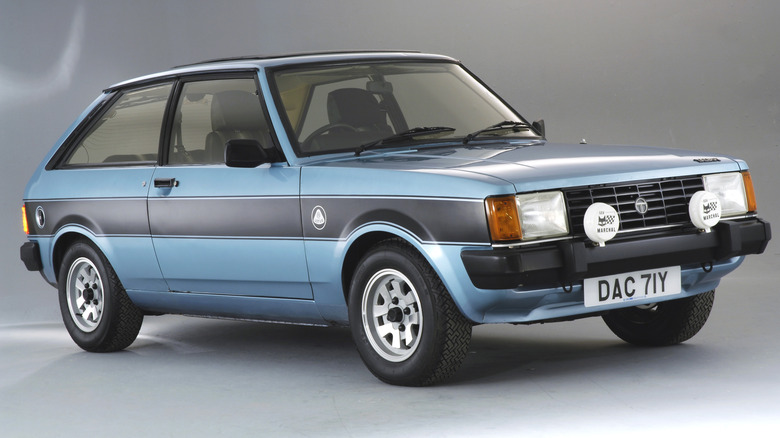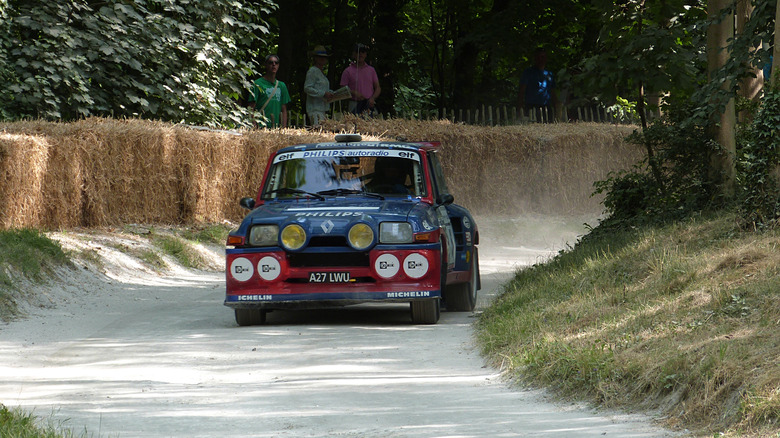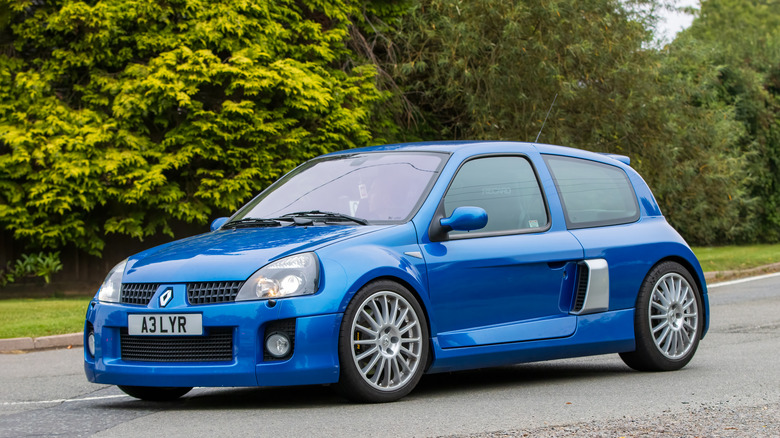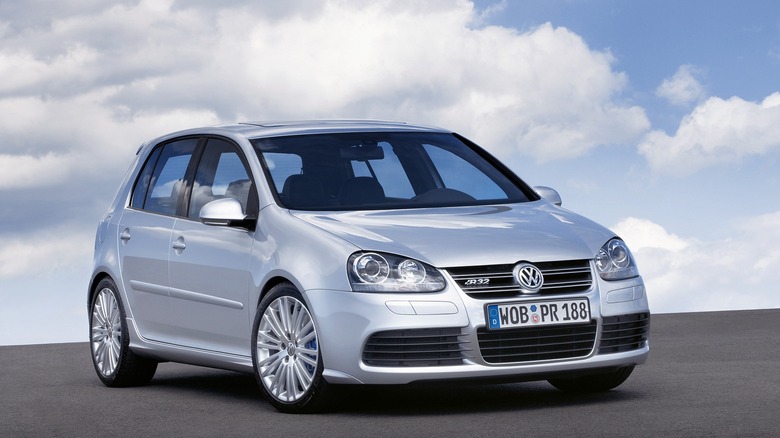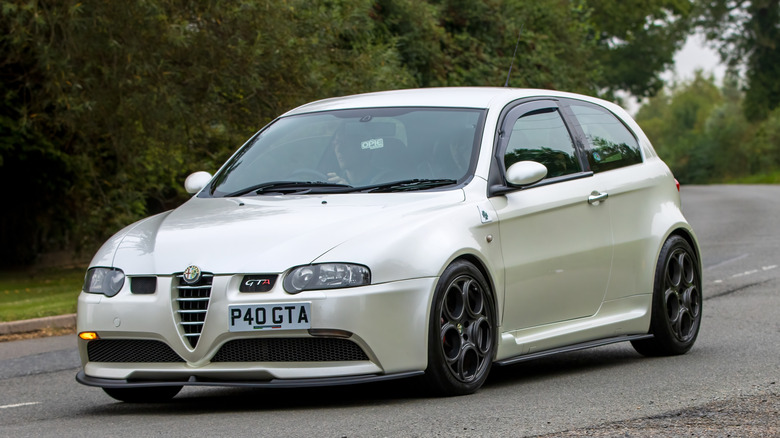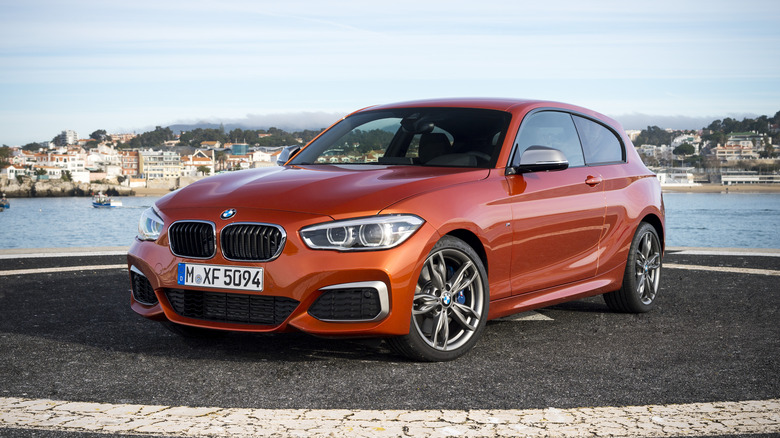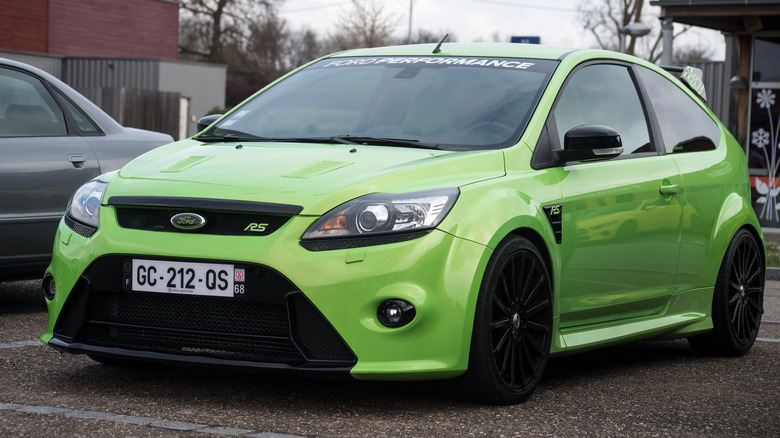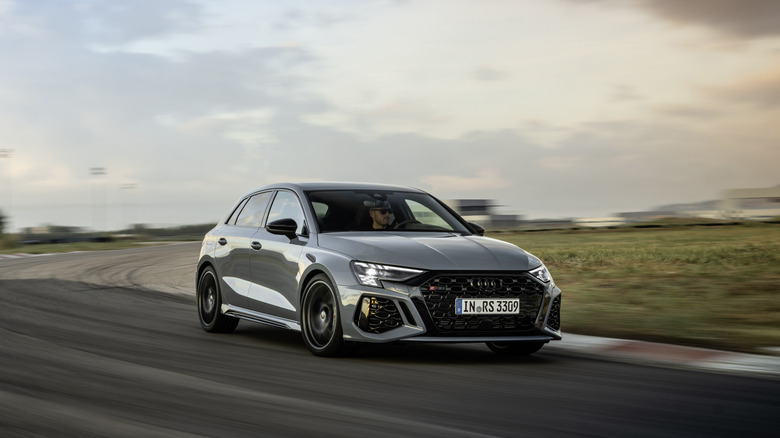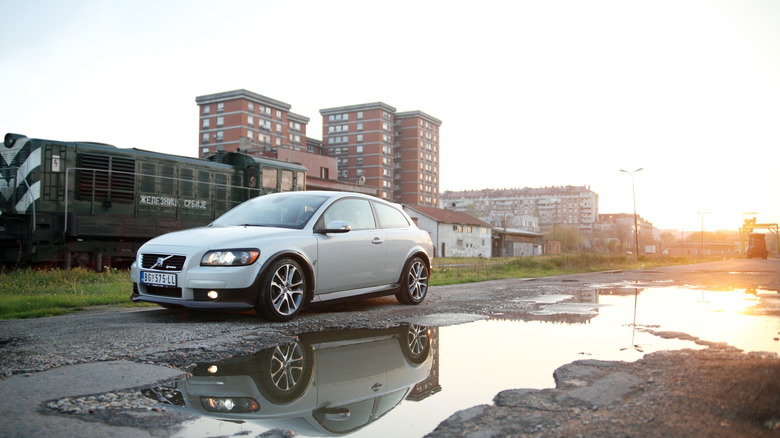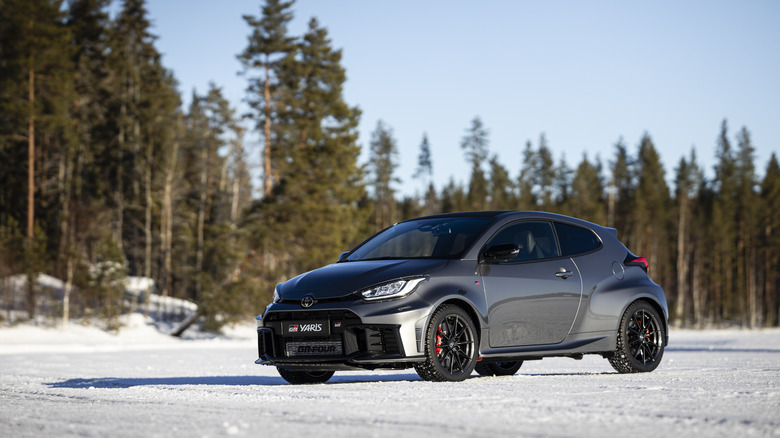10 Amazing Hot Hatchbacks The Likes Of Which We'll Never See Again
50 years ago, if you wanted a fast performance car and a practical small car, you had to endure a compromise. That compromise was, more often than not, owning both at the same time. While this had its strengths, it also had quite a few weaknesses. Eventually, several automakers agreed that the weaknesses outweighed the strengths, and they had a eureka moment: the hot hatchback.
The idea was joyously simple, yet so effective. It is a small hatchback with all the benefits that a small hatchback brings, like decent fuel efficiency, daily usability, and a fair bit of practicality, mixed in with much better performance, both on the straights and in the corners. After the original Volkswagen Golf GTI catapulted the popularity of the hot hatchback, various other automakers joined in on the action.
While most hot hatchbacks tended to follow a similar formula, there were a few occasions when the hot hatch template was taken to the absolute extreme. With the advent of ever-so-tightening emissions regulations and electric power, it's not likely we'll ever see another envelope-pushing hot hatchback powered by internal combustion and dead dinosaurs.
Sunbeam Lotus
Back in the 1970s, the Ford Escort was an incredible rally machine. With so many rally wins to its name, other automakers wanted in on the action. Chrysler UK, which was different from what America calls Chrysler, decided to enter their own compact Sunbeam into the Group 4 championships, and they enlisted the help of a small Hethel-based outfit that was quite good at making cars handle: Lotus.
The result was the Lotus Sunbeam, or as the fanbase refers to it, the Sunbeam Lotus. Interestingly, the Sunbeam Lotus came along when Peugot purchased Chrysler UK and rebadged it as Talbot. The Sunbeam Lotus was a homologation special in the true sense of the word, and despite its similarities to the regular Sunbeam, under the skin, there were some major changes.
The Sunbeam's lineup of pushrod and SOHC four-cylinder engines weren't cutting it, so in their place came a 2.2-liter Type 911 I4 directly from Lotus. It put out 150 horsepower and that went entirely to the rear wheels through a five-speed manual transmission sourced from ZF. The rally version helped Talbot secure the win for manufacturers at the 1981 World Rally Championship.
Renault 5 Turbo
The Group 4 rally class laid the foundations for what would eventually become Group B, undoubtedly rallying's most infamous era. One of the most well-known special cars to come out of the Group 4 era was the Renault 5 Turbo. The Renault 5 in itself was a standard front-engine, front-wheel drive compact car that the French automaker also offered in North America under the Renault Le Car moniker.
This was something different. Despite resembling the regular Renault 5, that car and the Turbo were about as similar as apples and oranges. Instead of rear seats, there was a 1.4-liter turbocharged I4 plucked from the already fizzy Renault 5 Alpine Turbo. It used a longitudinal layout, and it's RWD rather than FWD. TWR, the same folks behind the Jaguar XJ220S helped out the engineering.
All of that was clad in a fantastically boxy, widened body penned by Marcello Gandini of Bertone. You may have heard of him. The 5 Turbo road car developed a pretty healthy 160 horsepower, while the rally car bumped that up to 210 horsepower, and a later revision of the rally car brought that up to an incredible 350 horsepower. Today, the Renault 5 Turbo and Turbo 2 are undeniable classics, and their values are through the roof. Renault even recently brought back the 5 Turbo as an all-electric RWD drift machine. The only automaker that would try Renault's wild concept of a mid-engine, RWD hot hatchback a second time was ironically Renault itself.
Renault Clio V6 Renault Sport
A little over 15 years after the Renault 5 Turbo, the French automaker decided to give it another shot. The Clio, the Renault 5's direct descendant, became the guinea pig for this idea. The result was the Clio V6 Renault Sport, or as most people know it, the Clio V6. In many ways, it was the same idea as the Renault 5. A custom body resembling the Clio, when the two had very little in common, and a powerful engine in place of the rear seats driving the rear wheels.
But while the 5 Turbo had to make do with a turbocharged I4 with around 160 horsepower, the Clio V6 upped the ante with a full 2.9-liter naturally-aspirated V6. The engine in question was the ES/L V6, jointly built by Peugeot/Citroen and Renault.
The Clio V6 put out 227 horsepower in the initial Phase 1 run, but when Phase 2 came along in 2003, that rose to 247 horsepower, more than even the most powerful hot hatches of the time. Like the 5 Turbo, the Clio V6 was also co-engineered with TWR and was partially built in Sweden. While electric car platforms allow for mid-engine, RWD hatchbacks like this to return in theory, there likely won't be another with a massive V6.
Volkswagen Golf R32
Volkswagen started experimenting with six-cylinder power in their ubiquitous Golf in the 90s. The Mk3 generation brought along the Golf VR6 and VR6 Syncro. When the Mk4 generation came along, VW decided to leverage a top-of-the-line performance model using their innovative VR6 powertrain, and that was the Golf R32, known in North America simply as the R32.
At the heart of both generations of the R32 lay a 3.2-liter version of the VR6 engine. This was a very unconventional engine design, but it was genius in many ways: it was technically a V6, but there's only a 15-degree angle between the cylinder banks, which meant the engine didn't need two heads like every other V6, thus making it more compact and able to be mounted in a transverse layout vehicle with FWD, like the Golf.
In the Mk4, the VR6 put out 240 horsepower, whereas the Mk5 bumped that up to 250 horsepower. It wasn't the fastest, but it produced one of the most unique engine notes out there, and that's in the best sense of the word. It also had very different characteristics to, say, the GTI, thanks to being naturally aspirated and a little heavier at the nose. The R32 didn't sell in huge numbers, which has worked wonders for the car's value on the used market.
Alfa Romeo 147 GTA
As the early 2000s came along, the super hot hatch revolution was well underway in Europe. The Ford Focus RS and the Mk4 Golf R32 pushed the envelope when it came to raw horsepower on a hot hatchback, along with finding creative ways to harness the power and keep the car on the road. Alfa Romeo decided to join in with their own take on the super hatch. They took their Golf-rivaling 147 hatchback and stuck an absolute peach of an engine under the hood to create the 147 GTA.
The rather special 3.2-liter Busso V6 under the hood is an object of pure lust for so many enthusiasts, especially those of the Alfa Romeo variety. With 250 horsepower, the 147 GTA was the most powerful hot hatchback with a conventional FF layout, beating out the Ford and the Golf. While the straight-line performance and the noise it made were M-rated, Alfa forgot one important thing.
Keeping the 147 GTA front-wheel drive and giving it a massive, heavy V6 engine was already a big ask, but not doing anything meaningful with the drivetrain meant that the 147 GTA was quite the handful. However, it can be a total dream with the right aftermarket remedies. If you're ready to put up with maintenance on a 20-year-old Alfa Romeo, it's a magical experience.
BMW M135i (F21)
After the original Golf GTI kickstarted the hot hatchback craze, most automakers collectively agreed that the hot hatch should be front-engine and front-wheel drive. With only a handful of small exceptions, pretty much every modern hot hatchback followed and continues to follow this formula, and no one attempted a front-engine, rear-driven small performance car for quite a while. Not until BMW had something to say about it.
BMW took their smallest 1 Series, which only existed in North America as a Coupe, and turned it into a proper hot hatch. The resulting M135i was RWD, and it was powered by a 3.0-liter turbocharged six-cylinder engine putting out 315 horsepower. It may have been a hatchback, but it was a true BMW at heart, with six-cylinder power and Sheer Driving Pleasure thanks to that platform.
The rear-driven one proved to be quite a handful, which is why BMW eventually started offering xDrive AWD as well. With the move to a transverse FWD platform for the most recent 1 Series, and relegating the six-cylinder engines to the majority of the M lineup, the F2x generation M135i and M140i would be the last ever six-cylinder hot hatchbacks.
Ford Focus RS (Mk2)
The original Ford Focus RS is, by modern standards, a pretty tame hot hatchback. Boasting 212 horsepower from a turbocharged four-cylinder engine, it was plenty fast in the early 2000s and that number was unfathomable by those standards, but nowadays, you can get a larger and more powerful engine in a Hyundai Santa Cruz. For the Focus RS' second generation, based on what Europe called the second generation Focus, Ford decided not to hold back, and it ended up becoming one of the most exciting modern hot hatchbacks.
Gone was the pretty ordinary four-cylinder, and in its place came something truly special. Like this generation of Focus ST, the RS used a modified version of Volvo's B5254T3 2.5-liter turbocharged I5. As well as producing a truly angry exhaust note, the Mk2 Focus RS put out a pretty significant 301 horsepower. All of that went to the front wheels, but thanks to suspension and drivetrain trickery, the Focus RS was more than ready to handle it.
All of that was wrapped up in a wild exterior with massive bumpers, huge model-specific alloy wheels, and an even bigger, rally car-inspired rear spoiler. The Mk2 Focus RS achieved 60 mph in just 5.9 seconds and topped out at 163 mph. Today, the Mk2 Focus RS is firmly a classic. That's especially true of the ultra-limited RS500.
Audi RS3
Similarly to the Focus RS, the Audi RS3 was a hot hatchback that offered an additional cylinder under the hood. While it seems as though we won't see another RS-badged Ford anytime soon, the RS3 is still alive and kicking. Moreover, the most recent RS3 is the last member of the dynasty: with the TT going out of production, the RS3 is the only automobile on the market to offer a five-cylinder engine.
The 2.5-liter TFSI I5 under the hood of the RS3 develops 400 horsepower and 368 lb-ft of torque. That's the kind of numbers that supercars were putting out just a couple of decades ago, but the RS3 goes further than that. As well as topping out at 174 mph with the right options, which is already crazy enough on its own, this is also a hot hatchback that you can specify with ceramic brakes.
It would seem as though Audi is leaning toward the RS3 being a baby compact supercar, and on paper at least, it truly deserves it. Audi also has a first-class seat on the electric car bandwagon, so this could very well be the last Audi to ever use a five-cylinder engine, ending a legacy that spans over four decades and multiple iconic models, like the rally-conquering Quattro and the first ever fast wagon, the RS2 Avant. As we found out, it really is special.
Volvo C30 T5 R-Design
Previewed by the SSC concept, the Volvo C30 was the Swedish answer to the BMW 1 Series and Mercedes A-Class. Aside from the spectacular design hearkening back to the original P1800ES, the C30 was also a practical and usable hatchback. It may have only had three doors, but it was plenty spacious and offered a more interesting, more understated alternative to the German competitors.
This was also true of the T5 R-Design, Volvo's idea of a hot hatchback. There was never a proper C30 Polestar or C30 R, but the T5 R-Design was as close as Volvo got, and it was the only one offered in the United States. Powered by a 2.5-liter turbocharged five-cylinder engine putting out 220 horsepower to the front wheels through a six-speed manual or a five-speed automatic transmission, the C30 T5 R-Design was good-looking, safe, and dependable.
It's also the last of a different breed: the understated hot hatchback. With all the Civic Type Rs and Mercedes-AMG A45s of the world, making a hot hatchback understated became pretty unfashionable for nearly every automaker. The C30, meanwhile, hid the five-cylinder lump and its tuned chassis very well under the simple, but very eye-catching bodywork. It's easy to see why the C30 has climbed in value.
Toyota GR Yaris
Despite being known by many as the most "boring" automaker, Toyota has recently morphed into somewhat of a genie for car enthusiasts: granting wishes at every corner. After their plans to take the most recent Yaris rallying fell through, Toyota simply decided to release the homologation special on its own. The resulting GR Yaris is not only one of the most special modern hot hatchbacks, but easily one of the most special ones of all time. It's a real shame that the GR Yaris continues to be forbidden fruit for North American consumers.
A bespoke three-door body created specifically for the GR Yaris hides a boosted three-pot making 268 horsepower, which jumped up in the most recent facelift to 300 horsepower. That power went to all four wheels through a rally-bred GR-FOUR AWD system and, until very recently, a mandatory manual transmission with three pedals. To call the GR Yaris an exciting car would be putting it very gently.
The more recent facelift also added a completely new interior inspired by rally cars to make the controls more accessible, as well as a rally car-inspired parking brake. For many gearheads, the Toyota GR Yaris is the perfect blend of everything. Even though Toyota is not letting dinosaur-powered engines go down without a fight, the GR Yaris is almost certainly evocative of the last hurrah of the internal combustion-engined hot hatchback. Let's enjoy it, and its cousin, the GR Corolla, while they're still around.
